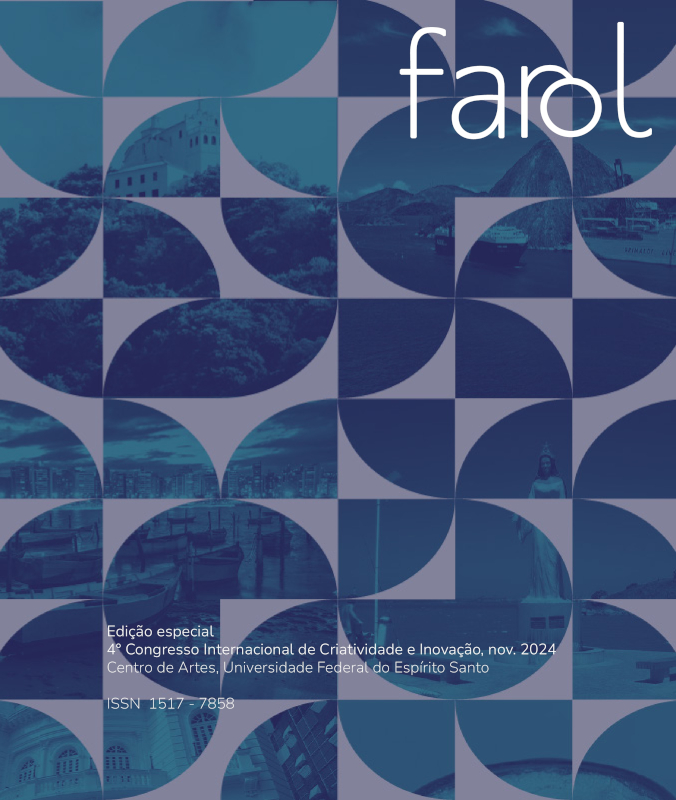Challenges to stimulate creativity in teaching innovation
Keywords:
active methodologies, innovation projects, stimulation of creativityAbstract
Innovation, nowadays, is essential to overcome the challenges that humanity faces in social, environmental and economic terms. To innovate, it is essential to be creative. Creativity can be taught and, in this article, we investigate the methodological proposal and the performance of the Innovation and Entrepreneurship Project Workshops - OPInE in stimulating the creativity of young people when creating innovative projects for their territories or municipalities. The research methodology was based on an online survey of six trainers who participated in the design and implementation of the OPInE training. The survey focused on aspects related to stimulating or blocking creativity. The creativity released was assessed by the trainers' perception of the originality of the projects. The main conclusion is that in the process of teaching innovation, the great challenge is to release the creativity of the learners.
Downloads
References
AMABILE, Teresa M. Como (não) matar a criatividade. HSM Management. Ano 2, n.12 pg 111-6, Jan/Fev 1999.
AMABILE, T. M.; PRATTI, M. G. The dynamic componential model of creativity and innovation in organizations: Making progress, making meaning. Research in Organizational Behavior, 36, 157–183, 2016.
ANDRES, Fabiane da Costa; ANDRES, Silvana Carloto; MORESCHI, Claudete; RODRIGUES, Sandra Ost; FERST, Maycol Ferreira. A utilização da plataforma Google Forms em pesquisa acadêmica: relato de experiência. Research, Society and Development, v. 9, n. 9, e284997174, 2020. Disponível em: https://orcid.org/0000-0003-0026-8114. Acesso em: 29/09/2024].
BLEDOW, R; FRESE, M.; ANDERSON, N.; EREZ, M; FARR, J. A dialectic perspective on innovation: conflicting demands, multiple pathways, and ambidexterity. Industrial and Organizational Psychology, 2(3): 305-337, 2009.
BROWN, Tim. Design thinking: uma metodologia poderosa para decretar o fim das velhas ideias. Rio de Janeiro: Campus: Elsevier, 2010.
BONO, Edward de. Serious creativity: using the power of lateral thinking to create new ideias. New York: HarperCollins, 1992.
DAVIS, G. Barriers to Creativity and Creative Attitudes. In M. RUNCO, & S. PRITZKER, Encyclopedia of Creativity, Vol I Ae-h (pp. 165-174). New York: Academic Press, 1999.
DESIGN COUNCIL (2024). History of the double diamond. A universally accepted depiction of the design process. Disponível em: https://www.designcouncil.org.uk/our-resources/the-double-diamond/history-of-the-double-diamond/
ESPÍRITO SANTO. Diário Oficial dos Poderes do Estado, Vitória, 12 mar. 2024.
FONSECA, A. Fernandes da. A Psicologia da Criatividade. Porto: Universidade Fernando Pessoa, 1998.
GOLEMAN, D., KAUFMAN, P., & RAY, M. Espírito criativo. (Trad. de The Creative Spirit ). São Paulo: Cultrix, 1992.
GONG, Y., HUANG, J.-C., FARH, J.-L. Employee learning orientation, transformational leadership, and employee creativity: The mediating role of employee creative self-efficacy. Academy of Management Journal, 765–778, 2009.
ISAKSEN, S., PUCCIO, G., & TREFFINGER, D. An Ecological Approach to Creativity Research: Profiling for Creative Problem Solving. In Journal of Creative Behavior. Volume 27, Number 3, Third Quarter (pp. 149-170), 1993.
JOHNSON, Steven. De onde vem as boas ideias: uma breve história da inovação. Zahar, 2021.
MENDES, Rosana Maria; MISKULIN, Rosana Giaretta Sguerra. A análise de conteúdo como uma metodologia. Cadernos de Pesquisa, v. 47, n. 165, p. 1044-1066, jul./set. 2017. Disponível em: https://doi.org/10.1590/198053143988. Acesso em: 29/09/2024.
MONTEIRO, R.L.S; SANTOS, D.S. A utilização da ferramenta Google Forms como instrumento de avaliação do ensino na escola superior de guerra. Revista Carioca de Ciência, Tecnologia e Educação (online). 4(.2):28-38, 2019. Disponível em: https://recite.unicarioca.edu.br/rccte/index.php/rccte/article/view/72/106. Acesso em: 29/09/2024.
MOTA, J.S. (2019) Utilização do google forms na pesquisa acadêmica. Revista Humanidades e Inovação 6(12):372 - 380. Disponível em: https://revista.unitins.br/index.php/humanidadeseinovacao/article/view/1106. Acesso em: 29/09/2024.
NACHMANOVITCH, S. (1993). Ser Criativo: o poder da improvisação na vida e na arte. 4ª Edição. São Paulo: Summus Editorial, 1993.
NECK, H.; NECK, C.; MURRAY, K. Entrepreneurship: the practices and the mindset, 2021.
O´DONNELL, Ken. Caminhos para uma consciência mais elevada. 13a edição. São Paulo: Brahma Kumaris Editora, 2019.
PAPAGEORGIOU, Kyriaki; KOKSHAGINA, Olga. Envisioning the future of learning for creativity, innovation and entrepreneurship. 1a. ed. Berlin, Boston: De Gruyter, 2022.
PINTO, Miriam de Magdala; FONSECA, Letícia Pedruzzi; CASTRO, Eustáquio V. R. Reflexões sobre ensino-aprendizagem em criatividade, inovação e empreendedorismo no ambiente acadêmico do ensino superior. In: Ciência, tecnologia e inovação para um Espírito Santo justo, sustentável e desenvolvido: contribuições da etapa estadual para a 5ª Conferência Nacional de CT&I / Organizadora Elda Coelho de Azevedo Bussinguer – São Paulo: Tirant lo Blanch, 2024.
PINTO, Miriam de Magdala; FONSECA, Letícia Pedruzzi. Investigação de iniciativas de ensino de inovação e empreendedorismo: uma abordagem a partir de experiências brasileiras e catalãs. Vitória, ES: PROEX, 2023.
PROCTOR, Tony. Creative problem solving for managers: developing skills for decision making and innovation. 2ª Edição. New York: Routledge, 2005.
RAVEN, J. Competence in modern society: its identification, development and release. London: H. K. Lewis & Co Ltda., 1984.
RICHARDS, L. Children’s ministry: nurturing faith within the family of God. USA: Zondervan, 1988.
SBPC - Sociedade Brasileira para o Progresso da Ciência. Disponível em: https://portal.sbpcnet.org.br/noticias/desenvolvimento-da-inovacao-no-brasil-comeca-com-politicas-integradas-de-cti-e-educacao/ Acesso em: 29/09/2024.
SILVA JÚNIOR, Severino Domingos da; COSTA, Francisco José. Mensuração e Escalas de Verificação: uma Análise Comparativa das Escalas de Likert e Phrase Completion. PMKT – Revista Brasileira de Pesquisas de Marketing, Opinião e Mídia, São Paulo, v. 15, p. 1-16, out. 2014. (ISSN 2317-0123 On-line).
TORRE, Saturnino de la. Dialogando com a criatividade. São Paulo: Madras, 2005.
TORRE, Saturnino de la. Aprender com os erros: o erro como estratégia de mudança. Petrópolis: Artmed, 2007.
WEINER, Rui Silvestre de Bastos. A criatividade no ensino do design. Dissertação (Mestrado em Design) – Faculdade de Belas Artes, Universidade do Porto. Porto, p. 90. 2020.
Downloads
Published
How to Cite
Issue
Section
License
Copyright (c) 2024 Miriam de Magdala Pinto

This work is licensed under a Creative Commons Attribution-NonCommercial-ShareAlike 4.0 International License.
The authors of works submitted to Revista Farol authorize their publication in physical and electronic media, solely for academic purposes, and may be reproduced as long as the source is cited. They attest to their originality, authorship and originality.





